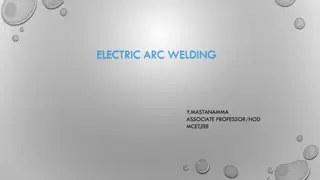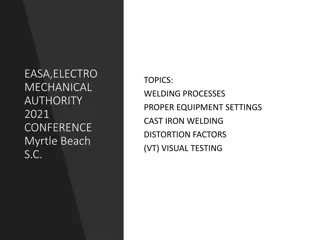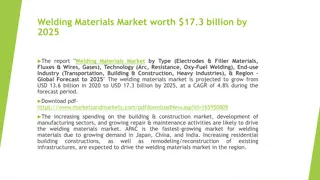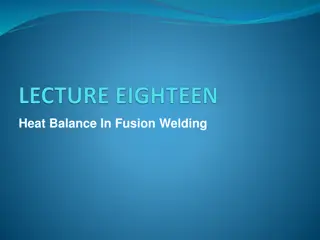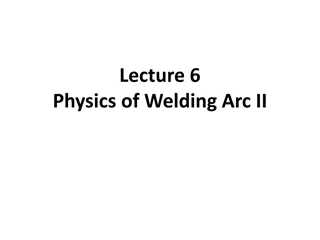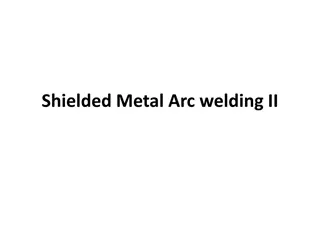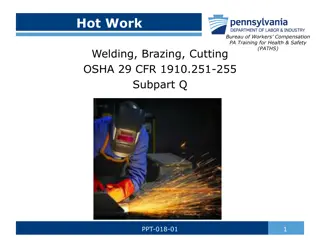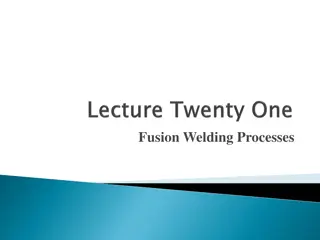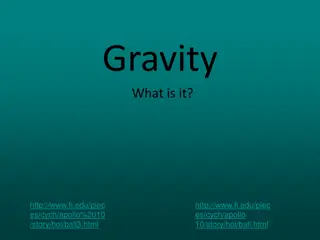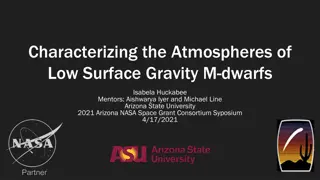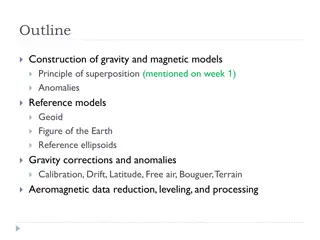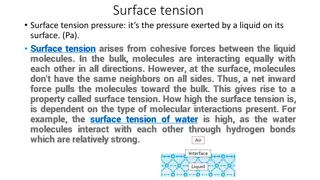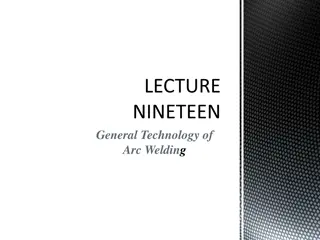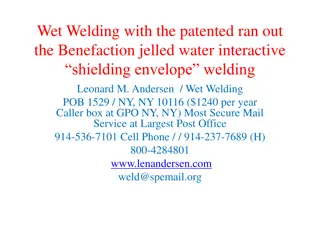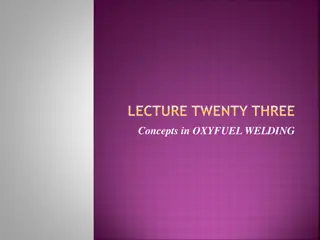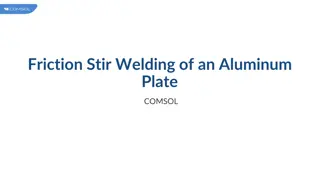Understanding Arc Forces in Welding: Gravity and Surface Tension Forces
Explore the significance of arc forces in welding, focusing on gravity and surface tension forces. Learn how these forces impact metal transfer, deposition efficiency, and welding quality. Discover the role of gravitational force in detachment and transfer of molten metal, and how surface tension force affects droplet detachment and placement in different welding positions.
Download Presentation

Please find below an Image/Link to download the presentation.
The content on the website is provided AS IS for your information and personal use only. It may not be sold, licensed, or shared on other websites without obtaining consent from the author. Download presentation by click this link. If you encounter any issues during the download, it is possible that the publisher has removed the file from their server.
E N D
Presentation Transcript
Arc Forces and Their significance on Welding -Metal transfer is detachment and movement of molten metal from tip of the electrode to the weld pool in work piece is very important because: 1.Flight duration of molten metal drop in arc region affects the quality of weld metal and element transfer efficiency, and 2. Arc forces affect the deposition efficiency.
Arc Forces and Their significance on Welding -Arc forces are termed to all forces acting in the arc zone. -These forces resisting or enabling the detachment of molten metal drop hanging at the electrode tip which in turn affect the mode of metal transfer and weld metal disposition efficiencies. metal vapours surface tension e3 e1 e2 e4 impact of charge particles gravitational e1 to e4 stages in force generation due to gas eruption
Gravity Force -This is due to gravitational force acting on molten metal drop hanging at the tip of electrode. -Gravitational force depends on the volume of the drop and density of metal. -Gravitational force (Fg)= V g where (kg/m3) is the density of metal, V is volume of drop (m3) and g is gravitational constant (m/s2). -In case of down hand welding, gravitational force helps in detachment/transfer of molten metal drop from electrode tip -In case of overhead welding it prevents the detachment.
Surface Tension Force -The drop of the liquid metal hanging at the tip of electrode due to surface tension effect. -Magnitude of the surface tension force is influenced by the size of droplet, electrode diameter and surface tension coefficient. Where is the surface tension coefficient, Re is the radius of electrode tip and R is drop radius -This force tends to resist the detachment of molten metal drop from electrode tip and usually acts against gravitational force.
Surface Tension Force -In case of vertical and overhead welding positions, high surface tension force helps in placing the molten weld metal atrequired position more effectively by reducing tendency of falling down of molten weld metal -Accordingly, flux/electrode composition for odd position welding purpose must be designed to have viscous and high surface tension weld metal/slag. -An Increase in temperature of the molten weld metal reduces the surface tension coefficient hence this will reduce preventing effect of the surface tension force on detachment of the drop and so it will facilitate the detachment of drop from electrode tip.
Force Due to Impact of Charge Carriers -These forces generated du to movement of charged particles (ions & electrons) towards anode or cathode and colliding with them. -The motivation for this movement is polarity of the charged particles -These forces tend to prevent the detachment of the molten metal drop hanging at the tip of electrode -Force due to impact of charged particles F= m (dV/dt), where m is the mass of charged particles, V is the velocity and t is the time.
Force Due to Metal Vapours -These forces generated due to evaporation of molten metal from bottom of drop and weld pool and movement of that vapours in upward direction -Theses forces tend to prevent the detachment of droplet hanging at the tip of electrode due to upward movement of the metal vapours against the fall of the molten metal.
Force Due to Gas Eruption(Explosion) -Gases present in molten metal such as oxygen, hydrogen etc. may react with some of the elements (such as carbon) present in molten metal drop and form gaseous such CO2 -The growth of these gases in molten metal drop increases with time and leads to explosion of metal drops which in turn increases the spattering and reduces the control of handling the molten weld metal
Force Due to Electro Magnetic Field -Flow of current through the arc gap develops the electromagnetic field. -Interaction of this electromagnetic field with the charge carriers produces a force which tends to pinch the drop hanging at the tip of the electrode also called pinch force. -The pinch force reduces the cross section for molten metal drop near the tip of the electrode and thus helps in detachment of the droplet from the electrode tip
Effect of Electrode Polarity -For D. C. : -If electrode is connected to negative terminal of the power source then direct current electrode negative polarity (DCEN) or straight polarity. [Electrode( -) Workpiece (+)] is obtained -If electrode is connected to positive terminal of the power source then direct current electrode positive polarity (DCEP) or reverse polarity. [Electrode( +) Workpiece (-)] is obtained -For A. C. welding Polarity doesn t remain cons- tant as it changes in every half cycle of current.
Effect of Electrode Polarity -Selection of appropriate polarity is important for successful welding as it affects 1. distribution of heat generated by welding arc at anode and cathode, 2. stability of the arc and 3. cleanliness of weld
Heat Generation -In general, more heat is generated at the anode than the cathode. -Of total DC welding arc heat, about two-third of heat is generated at the anode and one third at the cathode. -This is due to high velocity electrons with anode that generates more heat than that of ions with cathode where electrons possess higher kinetic energy than the ions. -Ion being heavier than electrons do not get accelerated much so move at low velocity in the arc region.
Heat Generation -Therefore, DCEN polarity is commonly used with non-consumable electrode welding processes so as to reduce the thermal degradation of the electrodes. -Moreover, DCEP polarity facilitates higher melting rate deposition rate incase of consumable electrode welding process such as SAW and MIG etc.
Stability of Arc -All welding processes in which electrode is expected to emit free electrons required for easy arc initiation and their stability, -GTAW welding, tungsten electrode is expected to emit electrons for providing stable arc and therefore DCEN is commonly used except when cleaning action is required in case of reactive metals e.g. Al, Mg, Ti. -Shielded metal arc welding SMAW using covered electrode having low ionization potential elements provide better stable arc stability with DCEN than DCEP. However SMAW with DCEP gives smoother metal transfer.
Cleaning action -Good cleaning action is provided by mobile cathode spot because it loosens the tenacious refractory oxide layer during welding of aluminium and magnesium. -Therefore, work piece is made cathode and electrode is connected to positive terminal of the power source. Thus, use of DCEP results in required cleaning action. Further, during TIG welding, a compromise is made between the electrode life and cleaning action by selecting the A.C..
Arc Characteristic -In general, arc voltage increases with increase in arc length during welding due to reduction in charged particle density in arc zones thus resistance to the flow of current is increases (Resistance 1 / density of charged particle) . To compensate this arc voltage should be increased -However, the extent of increase in arc voltage with increase in arc length varies with process.
Arc Characteristic -Variation in charged particle density in arc zones is different for different welding processes such as SMAW, GMAW and GTAW thus one can see the difference in arc voltage vs. arc length relationship for these process. -For example, GTAW process due to tungsten electrode (having high electron emitting capability) results in higher charged particle density in arc region than GMAW and SMAW which in turn leads to lower arc voltage/arc length ratio for GTAW than LMAW & SMAW process.
Arc Blow -Arc blow is basically a deflection of a welding arc from its axis of the electrode. -According to the direction of deflection of arc with respect to welding direction, an arc blow may termed as be forward or backward arc blow. -Deflection of arc ahead of the weld pool in direction of the welding is called forward arc blow and that in reverse direction is called backward arc blow (Fig. 7.2 a-c)
Arc Blow -Deflection of arc during welding reduces the control over the handling of molten metal by making it difficult to apply the molten metal at right place. -A severe arc blow increases the spattering which in turn decreases the deposition efficiency of the welding process.
Arc Blow -Arc blow is mainly occurred during DC arc welding due to interaction between different electromagnetic fields in and around the welding arc -There are two common situations of interaction between electromagnetic fields that can lead to arc blow: -1.interaction between electromagnetic field due to flow of current through the arc gap and that due to flow of current through plates being welded. Any kind of interaction of this field with other electromagnetic fields leads to arc blow
Arc Blow -2. interaction between electromagnetic field due to flow of current through the arc gap and that is localized while welding near the edge of the plates. -The lines of electromagnetic fields are localized near the egde of the plates as these can flow easily through the metal than the air -Therefore distribution of lines of electromagnetic forces does not remain uniform around the arc
Mechanism of Arc Blow -Current flow is the same direction in the two conductors like polarities the two generated electromagnetic fields reject (resist ) each other -Current flow is not the same direction in the two conductors un like polarities the two generated electromagnetic fields attract each other ; Arc blow can be controlled by: 1.Reduction of the arc length so as to reduce the extent of misplacement of molten metal 2.Shifting to A. C. if possible so as to neutralize the arc blow occurring in each half 3. Directing the tip of the electrode in direction opposite to the arc blow.



